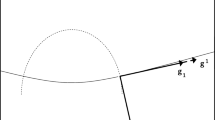Abstract
The behavior of fluid-dynamic (or macroscopic) quantities of rarefied gases is studied, with a special interest in its non-analytic feature near boundaries. It is shown that their gradients normal to the boundary diverge even if the boundary is smooth, irrespective of the value of the (nonzero) Knudsen number. The boundary geometry determines the diverging rate. On a planar or concave boundary, the logarithmic divergence \(\ln s\) should be observed, where s is the normal distance from the boundary. In other cases, the diverging rate is enhanced to be the inverse-power \(s^{-1/n}\), where \(n({\ge }2)\) is the degree of the dominant terms of the polynomial which locally represents the boundary. Some numerical demonstrations are given as well.









Similar content being viewed by others
Notes
The source S arises in the equation, if we put \(f=\left( 1+\phi +g\right) E\) with g being a given function. Then, S is related to g as \(S=-\zeta _i\frac{\partial g}{\partial x_i}+\mathcal {L}[g]\) and is usually analytic in both \(\varvec{x}\) and \(\varvec{\zeta }\). Such a formulation is common in treating, for instance, the Poiseuille and thermal creep (transpiration) flow problems. See, e.g., Refs. [10, 13].
By definition, \(F_{1}(x)=\gamma +\ln (x)+\mathrm {E}_{1}(x)=\gamma -\int _{x}^{1}t^{-1}dt+\int _{x}^{\infty }t^{-1}e^{-t}dt=\gamma -\int _{x}^{1}t^{-1}\left( 1-e^{-t}\right) dt+\int _{1}^{\infty }t^{-1}e^{-t}dt\). It is easy to see that \(x-F_{1}(x)\) is a monotonically increasing function and \(F_1(0)=0\), so that \(x\ge F_{1}(x)\ge 0\) for \(x>0\). Since \(2\sqrt{x}\ge x\) for \(0<x\le 1\), the desired inequality holds in this interval. For \(x>1\), consider \(g(x)\equiv 2\sqrt{x}-F_{1}(x)\). Then, g is a monotonically increasing function, because \(g^{\prime }(x)=x^{-1}\left( \sqrt{x}-1+e^{-x}\right) \ge 0\) for \(x\ge 1\). Therefore, \(g(x)\ge g(1)=2-\gamma -\int _{1}^{\infty }t^{-1}e^{-t}dt\ge 2-\gamma -e^{-1}>0\), which shows the desired inequality to hold for \(x>1\) as well.
Here, the value on the negative real axis is taken as the limit from above.
Here \(x_{w}\) is the \(x_{1}\)-coordinate of the intersection point of the molecular trajectory with the boundary. Hence \(x_{w}\) is one of the two solutions of \(x_{w}^{2}+\left( x_{w}-x_{1}\right) ^{2}\tan ^{2}\alpha =1\) or \(x_{w}^{2}-2x_{w}x_{1}\sin ^{2}\alpha +x_{1}^{2}\sin ^{2}\alpha -\cos ^{2}\alpha =0.\) We adopt the larger of the solutions \(x_{w}=x_{1}\sin ^{2}\alpha \pm \cos \alpha \left( 1-x_{1}^{2}\sin ^{2}\alpha \right) ^{1/2}\), which is the one with a positive sign.
Obviously \(G(x)\ge 0\) for \(x\ge 0\). If we introduce \(G_{n}(x)\equiv (1/n)x^{n}e^{x}-G(x)\) \((n>0)\), then we have \(G_{1}^{\prime }=x^{-1}\left\{ \left( x+x^{2}-1\right) e^{x}+1\right\} \equiv x^{-1}g_{1}(x)\). Because \(g_{1}^{\prime }=\left( 3x+x^{2}\right) e^{x}\ge 0\) and \(g_1(0)=0\), \(g_1(x)\) is non-negative for \(x\ge 0\). Therefore \(G_{1}\ge G_{1}(0)=0\). Now compare \(G_{1/2}\) with \(G_{1}\). Because \(G_{1/2}-G_{1}=\left( 2\sqrt{x}-x\right) e^{x}\), \(G_{1/2}\ge G_{1}\ge 0\) holds for \(x\le 1\). For \(x\ge 1\), \(G_{1/2}^{\prime }=x^{-1}\left\{ \left( x^{1/2}+2x^{3/2}-1\right) e^{x}+1\right\} \ge 0\) and thus \(G_{1/2}\ge G_{1/2}(1)\ge G_1(1)\ge 0\). Thus we conclude \(G_{1/2}(x)\ge 0\), i.e., \(0\le G(x)\le 2\sqrt{x}e^{x}\), for \(x\ge 0\).
In order to discriminate s against \(s\ln s\), the quantities near the outer boundary are shown by the semi-log plot of the difference from the values on the boundary divided by the distance s. If the profile for small s is horizontal line, the difference grows in proportion to s near the boundary. If the profile for small s is a straight line with non-zero slope, the difference grows in proportion to \(s\ln s\) near the boundary.
References
Bhatnagar, P.L., Gross, E.P., Krook, M.: A model for collision processes in gases. I. Small amplitude processes in charged and neutral one-component systems. Phys. Rev. 94, 511–525 (1954)
Chen, I.K.: Boundary singularity of moments for the linearized Boltzmann equation. J. Stat. Phys. 153, 93–118 (2013)
Guo, Y., Kim, C., Tonon, D., Trescases, A.: BV-regularity of the Boltzmann equation in non-convex domains. Arch. Rat. Mech. Anal. 220, 1045–1093 (2016). doi:10.1007/s00205-015-0948-9
Guo, Y., Kim, C., Tonon, D., Trescases, A.: Regularity of the Boltzmann equation in convex domains. Inv. Math. 207, 115–290 (2016). doi:10.1007/s00222-016-0670-8
Hattori, M., Takata, S.: Second-order Knudsen-layer analysis for the generalized slip-flow theory I. Bul. Inst. Math. Acad. Sin. New Series 10, 423–448 (2015)
Sone, Y.: New kind of boundary layer over a convex solid boundary in a rarefied gas. Phys. Fluids 16, 1422–1424 (1973)
Sone, Y.: Highly rarefied gas around a group of bodies with various temperature distributions I. Small tempearature variation. J. Méc. Théor. Appl. 3, 315–328 (1984)
Sone ,Y.: Highly rarefied gas around a group of bodies with various temperature distributions II. Arbitrary temperature variation. J. Méc. Théor. Appl. 4, 1–14 (1985)
Sone, Y.: Kinetic Theory and Fluid Dynamics. Birkhäuser (2002)
Sone, Y.: Molecular Gas Dynamics. Birkhäuser (2007). http://hdl.handle.net/2433/66098
Sone, Y., Aoki, K.: Negative thermophoresis: thermal stress slip flow around a spherical particle in a rarefied gas. In: Fisher, S.S. (ed.) Rarefied Gas Dynamics, pp. 489–503. AIAA, New York (1981)
Sone, Y., Takata, S.: Discontinuity of the velocity distribution function in a rarefied gas around a convex body and the S layer at the bottom of the Knudsen layer. Transp. Theor. Stat. Phys. 21, 501–530 (1992)
Takata, S., Funagane, H.: Singular behaviour of a rarefied gas on a planar boundary. J. Fluid Mech. 717, 30–47 (2013)
Takata, S., Yoshida, T., Noguchi, T., Taguchi, S.: Singular behavior of the macroscopic quantities in the free molecular gas. Phys. Fluids 28, 022002 (2016)
Welander, P.: On the temperature jump in a rarefied gas. Ark. Fys. 7, 507–553 (1954)
Author information
Authors and Affiliations
Corresponding author
Rights and permissions
About this article
Cite this article
Takata, S., Taguchi, S. Gradient Divergence of Fluid-Dynamic Quantities in Rarefied Gases on Smooth Boundaries. J Stat Phys 168, 1319–1352 (2017). https://doi.org/10.1007/s10955-017-1850-7
Received:
Accepted:
Published:
Issue Date:
DOI: https://doi.org/10.1007/s10955-017-1850-7



